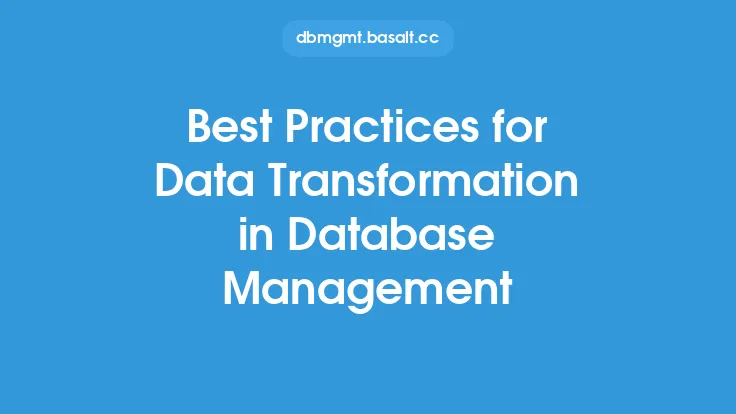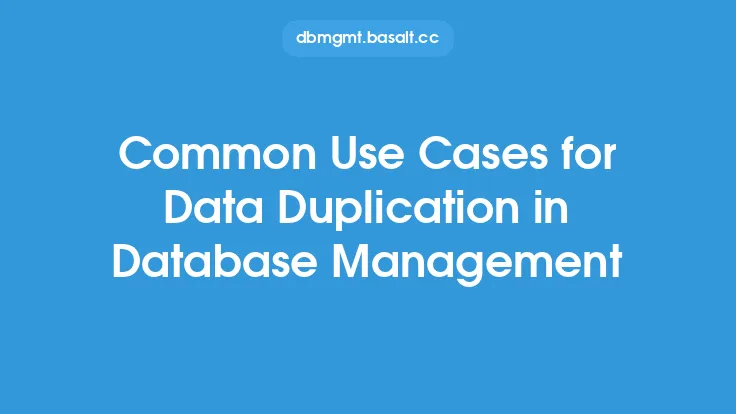The Internet of Things (IoT) has led to an explosion of data from various devices, sensors, and applications, making it essential to design and implement efficient database architectures for managing this data. IoT data management involves handling large volumes of data from diverse sources, ensuring data integrity, and providing real-time insights. In this article, we will delve into the database architecture patterns for IoT data management, exploring the key considerations, challenges, and best practices for designing scalable and efficient databases.
Overview of IoT Data Management
IoT data management involves collecting, processing, and analyzing data from various devices, sensors, and applications. The data can be structured, semi-structured, or unstructured, and it can be generated at varying velocities, from periodic updates to real-time streams. IoT data management requires a database architecture that can handle large volumes of data, provide low-latency data access, and support real-time analytics.
Key Considerations for IoT Database Architecture
When designing a database architecture for IoT data management, several key considerations must be taken into account. These include:
- Scalability: The database architecture should be able to handle increasing volumes of data and scale horizontally to support growing IoT deployments.
- Data Variety: The database should be able to handle diverse data formats, including structured, semi-structured, and unstructured data.
- Data Velocity: The database should be able to handle high-velocity data streams, providing low-latency data access and real-time analytics.
- Data Security: The database should ensure data security and integrity, protecting against unauthorized access and data breaches.
- Data Analytics: The database should support real-time analytics, enabling insights and decision-making.
Database Architecture Patterns for IoT
Several database architecture patterns can be used for IoT data management, including:
- Time-Series Database Architecture: This pattern is optimized for handling large volumes of time-stamped data, providing efficient data storage and retrieval.
- NoSQL Database Architecture: This pattern is suitable for handling diverse data formats, including structured, semi-structured, and unstructured data.
- Cloud-Native Database Architecture: This pattern takes advantage of cloud computing, providing scalable and on-demand database resources.
- Edge Computing Database Architecture: This pattern involves processing data at the edge of the network, reducing latency and improving real-time analytics.
- Federated Database Architecture: This pattern involves integrating multiple databases, providing a unified view of data and supporting real-time analytics.
Time-Series Database Architecture
Time-series database architecture is optimized for handling large volumes of time-stamped data, providing efficient data storage and retrieval. This pattern is suitable for IoT applications that generate periodic or real-time data, such as sensor readings or device telemetry. Time-series databases use specialized indexing and storage techniques, enabling fast data retrieval and aggregation.
NoSQL Database Architecture
NoSQL database architecture is suitable for handling diverse data formats, including structured, semi-structured, and unstructured data. This pattern is ideal for IoT applications that generate varied data types, such as device metadata, sensor readings, or application logs. NoSQL databases use flexible schema designs, enabling efficient data storage and retrieval.
Cloud-Native Database Architecture
Cloud-native database architecture takes advantage of cloud computing, providing scalable and on-demand database resources. This pattern is suitable for IoT applications that require elastic scalability, high availability, and reduced operational overhead. Cloud-native databases use cloud-based services, such as Amazon Web Services (AWS) or Microsoft Azure, to provide scalable and secure database resources.
Edge Computing Database Architecture
Edge computing database architecture involves processing data at the edge of the network, reducing latency and improving real-time analytics. This pattern is suitable for IoT applications that require low-latency data processing, such as real-time monitoring or autonomous systems. Edge computing databases use specialized hardware and software, enabling fast data processing and analytics at the edge of the network.
Federated Database Architecture
Federated database architecture involves integrating multiple databases, providing a unified view of data and supporting real-time analytics. This pattern is suitable for IoT applications that require data integration, such as device management or data analytics. Federated databases use standardized interfaces and protocols, enabling seamless data integration and exchange.
Best Practices for IoT Database Architecture
When designing a database architecture for IoT data management, several best practices should be followed:
- Use a scalable database design: Choose a database architecture that can scale horizontally to support growing IoT deployments.
- Select a suitable data model: Choose a data model that can handle diverse data formats and provide efficient data storage and retrieval.
- Ensure data security: Implement robust security measures to protect against unauthorized access and data breaches.
- Optimize for real-time analytics: Use specialized indexing and storage techniques to enable fast data retrieval and aggregation.
- Monitor and maintain the database: Regularly monitor and maintain the database to ensure optimal performance and data integrity.
Conclusion
Database architecture patterns for IoT data management are critical for handling large volumes of data from diverse sources, ensuring data integrity, and providing real-time insights. By understanding the key considerations, challenges, and best practices for designing scalable and efficient databases, developers and architects can create effective IoT data management systems. Whether using time-series, NoSQL, cloud-native, edge computing, or federated database architectures, the goal is to provide a robust and scalable database foundation for IoT applications, enabling real-time analytics, improved decision-making, and enhanced business outcomes.





